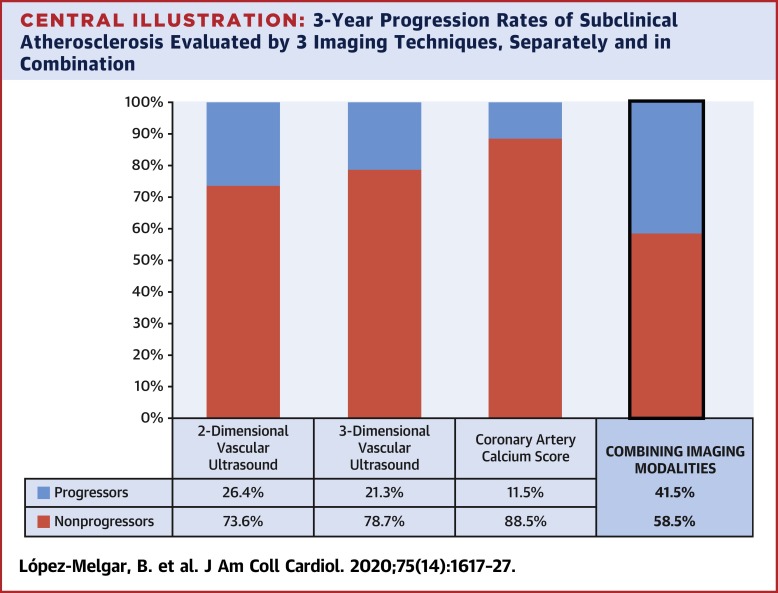当前位置:
X-MOL 学术
›
J. Am. Coll. Cardiol.
›
论文详情
Our official English website, www.x-mol.net, welcomes your
feedback! (Note: you will need to create a separate account there.)
Short-Term Progression of Multiterritorial Subclinical Atherosclerosis
Journal of the American College of Cardiology ( IF 21.7 ) Pub Date : 2020-04-01 , DOI: 10.1016/j.jacc.2020.02.026 Beatriz López-Melgar , Leticia Fernández-Friera , Belén Oliva , José Manuel García-Ruiz , Fátima Sánchez-Cabo , Héctor Bueno , José María Mendiguren , Enrique Lara-Pezzi , Vicente Andrés , Borja Ibáñez , Antonio Fernández-Ortiz , Javier Sanz , Valentín Fuster
Journal of the American College of Cardiology ( IF 21.7 ) Pub Date : 2020-04-01 , DOI: 10.1016/j.jacc.2020.02.026 Beatriz López-Melgar , Leticia Fernández-Friera , Belén Oliva , José Manuel García-Ruiz , Fátima Sánchez-Cabo , Héctor Bueno , José María Mendiguren , Enrique Lara-Pezzi , Vicente Andrés , Borja Ibáñez , Antonio Fernández-Ortiz , Javier Sanz , Valentín Fuster

|
BACKGROUND
Atherosclerosis progression predicts cardiovascular events; however, progression of multiterritorial subclinical atherosclerosis is incompletely understood. OBJECTIVES
This study sought to study short-term progression of atherosclerosis using different noninvasive imaging techniques and their relationship with cardiovascular risk. METHODS
The study included 3,514 PESA (Progression of Early Subclinical Atherosclerosis) study participants (45.7 ± 4.2 years of age; 63% men). Participants underwent 2-dimensional vascular ultrasound (2DVUS) of abdominal aorta, carotid, iliac, and femoral territories to determine a plaque number score; 3DVUS to quantify carotid and femoral plaque volume; and coronary artery calcium score (CACS) at baseline and 2.8 years later. The authors calculated the rate of new disease incidence and changes in disease extent. Logistic regression models were used to evaluate associations of progression rates with baseline cardiovascular risk factors and estimated 10-year risk. RESULTS
Imaging detected short-term (3-year) atherosclerosis progression in 41.5% of participants (26.4% by 2DVUS, 21.3% by 3DVUS, and 11.5% by CACS), particularly in peripheral territories examined by vascular ultrasound. New atherosclerosis onset accounted for approximately one-third of total progression, also more frequently by 2DVUS and 3DVUS (29.1% and 16.6%, respectively), than by CACS (2.9%). Participants with baseline disease by all 3 modalities (n = 432) also showed significant atherosclerosis progression (median: 1 plaque [interquartile range (IQR): -1 to 3 plaques] by 2DVUS; 7.6 mm3 [IQR: -32.2 to 57.6 mm3] by 3DVUS; and 21.6 Agatston units [IQR: 4.8 to 62.6 Agatston units] by CACS). Age, sex, dyslipidemia, hypertension, smoking, and family history of premature cardiovascular disease contributed to progression, with dyslipidemia the strongest modifiable risk factor. Although disease progression correlated with cardiovascular risk, progression was detected in 36.5% of participants categorized as low risk. CONCLUSIONS
With this multimodal and multiterritorial approach, the authors detected short-term progression of early subclinical atherosclerosis in a substantial proportion (41.5%) of apparently healthy middle-aged men and women, more frequently by peripheral 2D/3DVUS than by CACS. Disease progression, as defined in this study, correlated with almost all cardiovascular risk factors and estimated risk. (Progression of Early Subclinical Atherosclerosis [PESA]; NCT01410318).
中文翻译:

多区域亚临床动脉粥样硬化的短期进展
背景 动脉粥样硬化进展可预测心血管事件;然而,多地区亚临床动脉粥样硬化的进展尚不完全清楚。目的 本研究旨在使用不同的无创成像技术研究动脉粥样硬化的短期进展及其与心血管风险的关系。方法 该研究包括 3,514 名 PESA(早期亚临床动脉粥样硬化进展)研究参与者(45.7 ± 4.2 岁;63% 为男性)。参与者接受了腹主动脉、颈动脉、髂动脉和股骨区域的二维血管超声 (2DVUS) 以确定斑块数量评分;3DVUS 量化颈动脉和股骨斑块体积;基线和 2.8 年后的冠状动脉钙化评分 (CACS)。作者计算了新疾病的发生率和疾病范围的变化。Logistic 回归模型用于评估进展率与基线心血管危险因素和估计的 10 年风险之间的关联。结果 影像学检测到 41.5% 的参与者(2DVUS 为 26.4%,3DVUS 为 21.3%,CACS 为 11.5%)的短期(3 年)动脉粥样硬化进展,特别是在血管超声检查的外周区域。新发动脉粥样硬化约占总进展的三分之一,2DVUS 和 3DVUS(分别为 29.1% 和 16.6%)也比 CACS(2.9%)更频繁。通过所有 3 种方式(n = 432)患有基线疾病的参与者也显示出显着的动脉粥样硬化进展(中位数:1 个斑块 [四分位距 (IQR):-1 至 3 个斑块],2DVUS;7.6 mm3 [IQR:-32。2 至 57.6 mm3],由 3DVUS 提供;和 21.6 Agatston 单位 [IQR:4.8 至 62.6 Agatston 单位],由 CACS 提供)。年龄、性别、血脂异常、高血压、吸烟和早产心血管疾病家族史促成了进展,血脂异常是最强的可改变危险因素。尽管疾病进展与心血管风险相关,但在 36.5% 的低风险参与者中检测到进展。结论 通过这种多模式和多地域方法,作者检测到相当大比例 (41.5%) 明显健康的中年男性和女性的早期亚临床动脉粥样硬化的短期进展,外周 2D/3DVUS 比 CACS 更频繁。本研究中定义的疾病进展与几乎所有心血管危险因素和估计风险相关。
更新日期:2020-04-01
中文翻译:

多区域亚临床动脉粥样硬化的短期进展
背景 动脉粥样硬化进展可预测心血管事件;然而,多地区亚临床动脉粥样硬化的进展尚不完全清楚。目的 本研究旨在使用不同的无创成像技术研究动脉粥样硬化的短期进展及其与心血管风险的关系。方法 该研究包括 3,514 名 PESA(早期亚临床动脉粥样硬化进展)研究参与者(45.7 ± 4.2 岁;63% 为男性)。参与者接受了腹主动脉、颈动脉、髂动脉和股骨区域的二维血管超声 (2DVUS) 以确定斑块数量评分;3DVUS 量化颈动脉和股骨斑块体积;基线和 2.8 年后的冠状动脉钙化评分 (CACS)。作者计算了新疾病的发生率和疾病范围的变化。Logistic 回归模型用于评估进展率与基线心血管危险因素和估计的 10 年风险之间的关联。结果 影像学检测到 41.5% 的参与者(2DVUS 为 26.4%,3DVUS 为 21.3%,CACS 为 11.5%)的短期(3 年)动脉粥样硬化进展,特别是在血管超声检查的外周区域。新发动脉粥样硬化约占总进展的三分之一,2DVUS 和 3DVUS(分别为 29.1% 和 16.6%)也比 CACS(2.9%)更频繁。通过所有 3 种方式(n = 432)患有基线疾病的参与者也显示出显着的动脉粥样硬化进展(中位数:1 个斑块 [四分位距 (IQR):-1 至 3 个斑块],2DVUS;7.6 mm3 [IQR:-32。2 至 57.6 mm3],由 3DVUS 提供;和 21.6 Agatston 单位 [IQR:4.8 至 62.6 Agatston 单位],由 CACS 提供)。年龄、性别、血脂异常、高血压、吸烟和早产心血管疾病家族史促成了进展,血脂异常是最强的可改变危险因素。尽管疾病进展与心血管风险相关,但在 36.5% 的低风险参与者中检测到进展。结论 通过这种多模式和多地域方法,作者检测到相当大比例 (41.5%) 明显健康的中年男性和女性的早期亚临床动脉粥样硬化的短期进展,外周 2D/3DVUS 比 CACS 更频繁。本研究中定义的疾病进展与几乎所有心血管危险因素和估计风险相关。











































 京公网安备 11010802027423号
京公网安备 11010802027423号